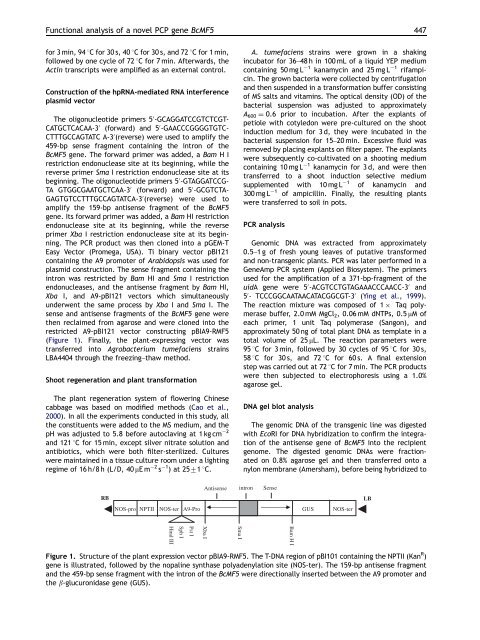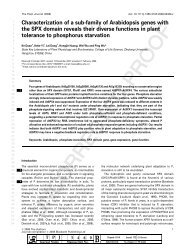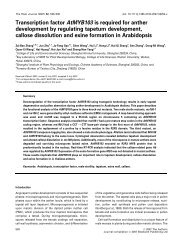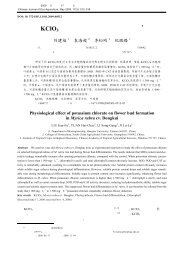Brassica campestris L. ssp. chinensis M
Brassica campestris L. ssp. chinensis M
Brassica campestris L. ssp. chinensis M
Create successful ePaper yourself
Turn your PDF publications into a flip-book with our unique Google optimized e-Paper software.
for 3 min, 94 1C for 30 s, 40 1C for 30 s, and 72 1C for 1 min,<br />
followed by one cycle of 72 1C for 7 min. Afterwards, the<br />
Actin transcripts were amplified as an external control.<br />
Construction of the hpRNA-mediated RNA interference<br />
plasmid vector<br />
The oligonucleotide primers 5 0 -GCAGGATCCGTCTCGT-<br />
CATGCTCACAA-3 0 (forward) and 5 0 -GAACCCGGGGTGTC-<br />
CTTTGCCAGTATC A-3 0 (reverse) were used to amplify the<br />
459-bp sense fragment containing the intron of the<br />
BcMF5 gene. The forward primer was added, a Bam HI<br />
restriction endonuclease site at its beginning, while the<br />
reverse primer Sma I restriction endonuclease site at its<br />
beginning. The oligonucleotide primers 5 0 -GTAGGATCCG-<br />
TA GTGGCGAATGCTCAA-3 0 (forward) and 5 0 -GCGTCTA-<br />
GAGTGTCCTTTGCCAGTATCA-3 0 (reverse) were used to<br />
amplify the 159-bp antisense fragment of the BcMF5<br />
gene. Its forward primer was added, a Bam HI restriction<br />
endonuclease site at its beginning, while the reverse<br />
primer Xba I restriction endonuclease site at its beginning.<br />
The PCR product was then cloned into a pGEM-T<br />
Easy Vector (Promega, USA). Ti binary vector pBI121<br />
containing the A9 promoter of Arabidopsis was used for<br />
plasmid construction. The sense fragment containing the<br />
intron was restricted by Bam HI and Sma I restriction<br />
endonucleases, and the antisense fragment by Bam HI,<br />
Xba I, and A9-pBI121 vectors which simultaneously<br />
underwent the same process by Xba I and Sma I. The<br />
sense and antisense fragments of the BcMF5 gene were<br />
then reclaimed from agarose and were cloned into the<br />
restricted A9-pBI121 vector constructing pBIA9-RMF5<br />
(Figure 1). Finally, the plant-expressing vector was<br />
transferred into Agrobacterium tumefaciens strains<br />
LBA4404 through the freezing–thaw method.<br />
Shoot regeneration and plant transformation<br />
The plant regeneration system of flowering Chinese<br />
cabbage was based on modified methods (Cao et al.,<br />
2000). In all the experiments conducted in this study, all<br />
the constituents were added to the MS medium, and the<br />
pH was adjusted to 5.8 before autoclaving at 1 kg cm 2<br />
and 121 1C for 15 min, except silver nitrate solution and<br />
antibiotics, which were both filter-sterilized. Cultures<br />
were maintained in a tissue culture room under a lighting<br />
regime of 16 h/8 h (L/D, 40 mEm 2 s 1 )at2571 1C.<br />
ARTICLE IN PRESS<br />
Functional analysis of a novel PCP gene BcMF5 447<br />
RB<br />
Antisense<br />
A. tumefaciens strains were grown in a shaking<br />
incubator for 36–48 h in 100 mL of a liquid YEP medium<br />
containing 50 mg L 1 kanamycin and 25 mg L 1 rifampicin.<br />
The grown bacteria were collected by centrifugation<br />
and then suspended in a transformation buffer consisting<br />
of MS salts and vitamins. The optical density (OD) of the<br />
bacterial suspension was adjusted to approximately<br />
A600 ¼ 0.6 prior to incubation. After the explants of<br />
petiole with cotyledon were pre-cultured on the shoot<br />
induction medium for 3 d, they were incubated in the<br />
bacterial suspension for 15–20 min. Excessive fluid was<br />
removed by placing explants on filter paper. The explants<br />
were subsequently co-cultivated on a shooting medium<br />
containing 10 mg L 1 kanamycin for 3 d, and were then<br />
transferred to a shoot induction selective medium<br />
supplemented with 10 mg L 1<br />
of kanamycin and<br />
300 mg L 1 of ampicillin. Finally, the resulting plants<br />
were transferred to soil in pots.<br />
PCR analysis<br />
Genomic DNA was extracted from approximately<br />
0.5–1 g of fresh young leaves of putative transformed<br />
and non-transgenic plants. PCR was later performed in a<br />
GeneAmp PCR system (Applied Biosystem). The primers<br />
used for the amplification of a 371-bp-fragment of the<br />
uidA gene were 5 0 -ACGTCCTGTAGAAACCCAACC-3 0 and<br />
5 0 - TCCCGGCAATAACATACGGCGT-3 0 (Ying et al., 1999).<br />
The reaction mixture was composed of 1 Taq polymerase<br />
buffer, 2.0 mM MgCl2, 0.06 mM dNTPs, 0.5 mM of<br />
each primer, 1 unit Taq polymerase (Sangon), and<br />
approximately 50 ng of total plant DNA as template in a<br />
total volume of 25 mL. The reaction parameters were<br />
95 1C for 3 min, followed by 30 cycles of 95 1C for 30 s,<br />
58 1C for 30 s, and 72 1C for 60 s. A final extension<br />
step was carried out at 72 1C for 7 min. The PCR products<br />
were then subjected to electrophoresis using a 1.0%<br />
agarose gel.<br />
DNA gel blot analysis<br />
The genomic DNA of the transgenic line was digested<br />
with EcoRI for DNA hybridization to confirm the integration<br />
of the antisense gene of BcMF5 into the recipient<br />
genome. The digested genomic DNAs were fractionated<br />
on 0.8% agarose gel and then transferred onto a<br />
nylon membrane (Amersham), before being hybridized to<br />
intron Sense<br />
NOS-pro NPTII NOS-ter A9-Pro<br />
GUS NOS-ter<br />
Hind III<br />
Sph I<br />
Pst I<br />
Xba I<br />
Figure 1. Structure of the plant expression vector pBIA9-RMF5. The T-DNA region of pBI101 containing the NPTII (Kan R )<br />
gene is illustrated, followed by the nopaline synthase polyadenylation site (NOS-ter). The 159-bp antisense fragment<br />
and the 459-bp sense fragment with the intron of the BcMF5 were directionally inserted between the A9 promoter and<br />
the b-glucuronidase gene (GUS).<br />
Sma I<br />
Bam H I<br />
LB








